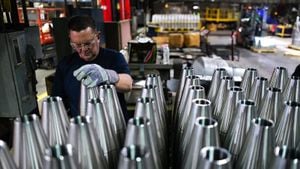The global automotive industry is positioning itself toward significant transformations as we approach the year 2025, driven primarily by the rise of electric vehicles (EVs) and the relentless march of technological advancements. Market trends indicate substantial shifts, particularly among established giants and new players aiming to carve out their niches.
One of the standout stories is the introduction of the Dongfeng Nammi 06, set to make waves not only in its home market of China but also across Europe. According to reports, this compact electric SUV is expected to attract European consumers with its competitive pricing and modern design. Dongfeng, a brand somewhat under the radar for many European customers, is working diligently to increase its brand recognition on the continent, having already laid the groundwork with models sold across Spain and other regions.
The Nammi 06's design is reminiscent of popular models like the KIA EV3 and Nissan Kicks, with technical roots shared with Nissan, allowing Dongfeng to leverage valuable expertise gained over two decades of producing vehicles alongside established brands. With dimensions just over 4.3 meters, the Nammi 06 positions itself firmly within the thriving compact SUV market.
Specifications are still scarce, but insights from China's Ministry of Industry and Information Technology suggest the vehicle will boast powerful configurations of up to 181 horsepower. Prices are speculated to start around €13,000, potentially making the Nammi 06 highly appealing to budget-conscious consumers eager for dependable EV options.
Another significant participant in the 2025 automotive narrative is the fierce competition within the compact luxury segment, with BMW and Audi each updating their respective offerings—BMW 1 Series and Audi A3. Following recent redesigns, both models have adopted more modern aesthetics coupled with advanced digital interfaces. BMW’s latest iteration introduces the larger double kidney grille and updated LED headlights, alongside substantial upgrades to its digital cockpit.
On the other hand, Audi remains loyal to its established design language, presenting wider frames and modified lighting features. Also noteworthy is Audi's new A3 Allstreet variant, which introduces crossover elements appealing to adventurous drivers.
Technologically, BMW shifts to its newest operating system, prioritizing touch and voice commands over traditional controls, which has sparked discussions among enthusiasts wary of loss of tactile feedback. Audi maintains its dual-screen setup but has enhanced connectivity features for added user convenience.
When examining storage capacities, BMW offers between 300 to 1,135 liters, adjustable via rear seats, whereas the Audi A3 grants users from 380 to 1,200 liters, likening both as competitive options for practicality and tech-savvy consumers.
Performance-wise, both automakers present broad engine options, starting with basic gasoline powertrains at 116 horsepower, extending to performance variants like BMW's M135 xDrive, which delivers 300 horsepower—demonstrative of the brand's athletic prowess.
Pricing becomes another key point of discussion, as the BMW 1 Series starts at €32,900 for the entry-level model compared to Audi's slightly less expensive A3 at €31,300. Discerning consumers must determine which model best aligns with their needs, as both brands bring strengths to the table.
Looking forward to 2025, the automotive market will likely flourish with more electric variations, boosting competition and incentivizing manufacturers to innovate. The efforts from Dongfeng, alongside the established names of BMW and Audi, highlight the dynamic shifts as companies gear up for not only meeting market demands but also aligning with global sustainability targets.
These shifts are reflective not only of consumer preferences but also of broader economic trends pushing for greener options. The electric vehicle market is expected to expand as policies worldwide increasingly favor eco-friendly technologies. This backdrop provides fertile ground for all players, making automotive analysis for 2025 rich with opportunity and innovation.



